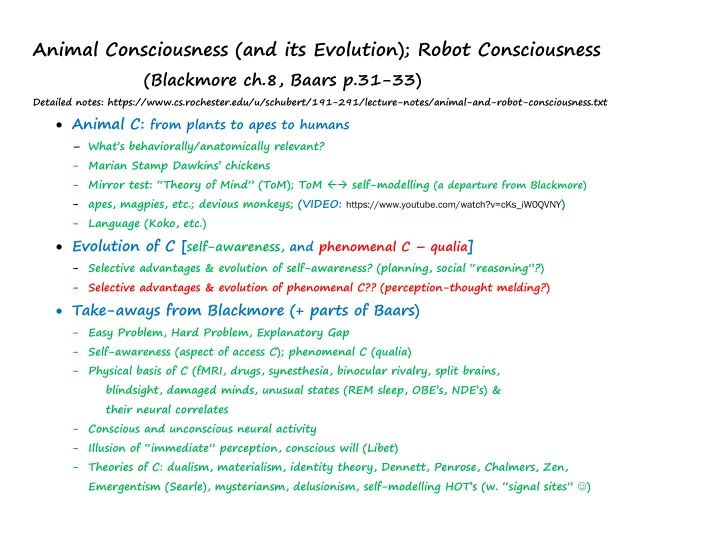

Animal Consciousness (and its Evolution); Robot Consciousness (Blackmore ch.8, Baars p.31-33) Detailed notes: https://www.cs.rochester.edu/u/schubert/191-291/lecture-notes/animal-and-robot-consciousness.txt • Animal C: from plants to apes to humans – What’s behaviorally/anatomically relevant? - Marian Stamp Dawkins’ chickens - Mirror test: “Theory of Mind” (ToM); ToM ßà self-modelling (a departure from Blackmore) - apes, magpies, etc.; devious monkeys; (VIDEO: https://www.youtube.com/watch?v=cKs_iW0QVNY ) - Language (Koko, etc.) • Evolution of C [ self-awareness, and phenomenal C – qualia ] - Selective advantages & evolution of self-awareness? (planning, social “reasoning”?) - Selective advantages & evolution of phenomenal C?? (perception-thought melding?) • Take-aways from Blackmore (+ parts of Baars) - Easy Problem, Hard Problem, Explanatory Gap - Self-awareness (aspect of access C); phenomenal C (qualia) - Physical basis of C (fMRI, drugs, synesthesia, binocular rivalry, split brains, blindsight, damaged minds, unusual states (REM sleep, OBE’s, NDE’s) & their neural correlates - Conscious and unconscious neural activity - Illusion of “immediate” perception, conscious will (Libet) - Theories of C: dualism, materialism, identity theory, Dennett, Penrose, Chalmers, Zen, Emergentism (Searle), mysteriansm, delusionism, self-modelling HOT’s (w. “signal sites” J )
Implications for Robots Blackmore: they’ll probably share our delusions (if sufficiently intelligent) Baars & Franklin: with the right architecture, they’ll be conscious "Consciousness is computational: The LIDA model of global workspace theory" (https://www.researchgate.net/publication/238423831_Consciousness_is_computational_The_LIDA_model_of_global_workspace_theory) Self-models with signal sites: We could create phenomenally conscious or unconscious (Zombie-like) robots, but the latter probably could not “thoughtfully” control their interactions Version 1: rote sensorimotor routines (with affordances) plus separate talk/thought Version 2: rote sensorimotor routines (with affordances) plus integrated talk/thought (via hyperpropositions in the self-model) (See Nao28 (that (touching Nao28 (right-hand-of Sue))) )
Theo Theories ries o of f ph phenomenal C (again (again - & & then en som some! e!): Dualism (Descartes, most people) All of the approaches that follow (except Monism (idealistic, materialistic, neutral) perhaps mysterianism) are materialistic Reductionism (Dennett, Baars, Churchland) Higher-order theories (McDermott, Rolls, Arbib, …) Emergentism (John Searle) Quantum effects (Penrose, Hameroff) Undiscovered property of information (Chalmers) Information-theoretic complexity/systematicity tradeoff of a system (Edelman, Tononi, Koch) Mysterianism (Colin McQuinn) Counterexamples to “ F ” demonstrated by Scott Aaronson Delusionism (Blackmore) Hyperpropositions (with “signal sites”) Property theory (based on Meinard Kuhlman, Sci. Am. Aug. 2013)
Recommend
More recommend